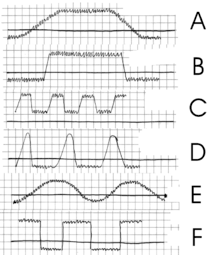Remittent fever
Remittent fever is a type or pattern of fever in which temperature does not touch the baseline and remains above normal throughout the day. Daily variation in temperature is more than 1°C in 24 hours, which is also the main difference as compared to continuous fever.[1][2][3] Fever due to most infectious diseases is remittent. Diagnosis is based upon clinical history, blood tests, blood culture and chest X-ray.[4]

Performance of the various types of fever
a) Fever continues
b) Fever continues to abrupt onset and remission
c) Remittent fever
d) Intermittent fever
e) Undulant fever
f) Relapsing fever
a) Fever continues
b) Fever continues to abrupt onset and remission
c) Remittent fever
d) Intermittent fever
e) Undulant fever
f) Relapsing fever
Examples
Examples of remittent fever are as following.[5]
Management
Management is carried out using antipyretics for fever and body aches. Antibiotics are used in case of infectious diseases and for infective endocarditis, in addition to antibiotics, cardiac valve prosthesis and mitral valve replacement surgery is used.[5][6]
References
- The Medical News and Library. Lea & Blanchard. 1843. p. 96 – via Internet Archive.
remittent fever news.
- Ogoina D (August 2011). "Fever, fever patterns and diseases called 'fever' – a review". Journal of Infection and Public Health. 4 (3): 108–24. doi:10.1016/j.jiph.2011.05.002. PMID 21843857.
- Dall, Lawrence; Stanford, James F. (1990). "Fever, Chills, and Night Sweats". In Walker, H. Kenneth; Hall, W. Dallas; Hurst, J. Willis (eds.). Clinical Methods: The History, Physical, and Laboratory Examinations. Butterworths. ISBN 978-0-409-90077-4. PMID 21250166 – via PubMed.
- Del Bene, Victor E. (1990). "Temperature". In Walker, H. Kenneth; Hall, W. Dallas; Hurst, J. Willis (eds.). Clinical Methods: The History, Physical, and Laboratory Examinations. Butterworths. ISBN 978-0-409-90077-4. PMID 21250173 – via PubMed.
- Lee SA, Kim KH, Shin HS, Lee HS, Choi HM, Kim HK (November 2014). "Successful Medical Treatment of Prosthetic Mitral Valve Endocarditis Caused by Brucella abortus". Korean Circulation Journal. 44 (6): 441–43. doi:10.4070/kcj.2014.44.6.441. PMC 4248619. PMID 25469149.
- Perrott DA, Piira T, Goodenough B, Champion GD (2004). "Efficacy and safety of acetaminophen vs ibuprofen for treating children's pain or fever: a meta-analysis". Archives of Pediatrics & Adolescent Medicine. 158 (6): 521–26. doi:10.1001/archpedi.158.6.521. PMID 15184213.
This article is issued from Wikipedia. The text is licensed under Creative Commons - Attribution - Sharealike. Additional terms may apply for the media files.